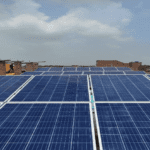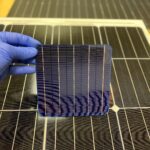We live in the age of automation and artificial intelligence. We need smartphones with long-lasting battery backup. We demand computers with higher computing power. In short, we require more and more energy. And when it comes to energy, we often turn to the most sustainable power alternative: solar energy.
Its abundance is not the only aspect that makes it the best candidate to fulfill increasing energy demand. Over the last few years, it has overcome several hurdles that prevented it from last-scale adoption. The global value of the market is increasing at a colossal compound annual growth rate of 20.5%.
The solar energy market has come a long way. In 2018, the market accounted for $52.5 billion, according to research firm Allied Market Research. Now, Allied Market Research predicts that the global solar energy market will reach $223.3 billion by 2026.
The surge in rooftop installation and rapid adoption in the architectural field are the prime drivers of the increasing demand for solar cells. Moreover, recent technological marvels have boosted the adoption of solar panels to generate electricity. For instance, researchers have developed a novel design that could squeeze more energy from solar panels. Additionally, the prices of solar panels have decreased significantly over the past couple of years. Moreover, researchers at the University of Houston recently published a paper unveiling a hybrid device that can both capture and store solar energy.
Apart from this, developing countries such as India are taking an active part in adopting solar energy. In fact, an Indian solar energy project recently bagged a $100,000 grand prize. It is expected that solar energy soon will be unbeatable compared to conventional sources of energy, if a few challenges can be overcome.
Solar Energy Challenges
Several countries are investing big bucks in solar energy. Although solar energy would be the energy source of all the futuristic advancements, it needs to be harnessed properly.
The most common applications of solar energy are for cooking purposes, and heating homes and water. However, not every country gets long hours of sunlight and that prevents them from harnessing solar energy.
Apart from this, one of the major challenges is the storage of solar energy. Moreover, the current solar battery storage systems are quite expensive. However, several modern solar panels have dealt with issues, but there still is a lot of scope for improvement.
Moreover, squeezing maximum efficiency out of a regular solar panel is another challenge. Currently, the silicon-based solar panel offers only 33% efficiency, which means most of the solar radiation is not used to generate electricity.
A Novel Way to Boost Solar Power
The dire need for generating the maximum amount of electricity from a solar panel has led researchers to look for another material for manufacturing solar panels. In fact, researchers in Australia and China have launched a novel solar cell that can harness maximum power from solar panels.
The product is made of perovskite, a structure that was discovered in the mid-1800s. The researchers used the material to develop cheaper and more efficient solar panels, which are more durable.
The hurdle of minimizing the manufacturing costs of solar panels is not easy to overcome. However, we can increase conversion efficiency. The degree to which a panel converts energy from sunlight into electricity defines the conversion efficiency. The conventional silicon-based photovoltaic panels offer a conversion efficiency of about 16% to 18%. However, the perovskite solar panel could provide an efficiency of about 35%, while reducing manufacturing costs.
The Invention of a New Hybrid Device
Solar panels and solar cells directly rely on photovoltaic technology for the generation of electricity. However, a novel hybrid device developed by researchers at the University of Houston can perform both the tasks of capturing solar energy and storing it until it is consumed.
The hybrid device is capable of capturing the heat from the sun and storing it in the form of thermal energy. This would enable the wide-scale adoption of solar power, as it would generate solar energy 24 x 7 regardless of limited sunlight hours and uncertain weather.
A paper on the subject was published in Joule. The researchers combined latent heat storage and molecular energy storage to generate integrated harvesting and keep the device operational around the clock. According to the researchers, the device offers harvesting efficiency of 73% at small-scale operation and around 90% at large-scale operation. Moreover, it is observed that up to 80% of stored energy can be recovered at night, and the recovery during daylight is even higher.
The device is developed using norbornadiene-quadricyclane as the molecular storage material. It is an organic compound that showcases high specific energy and exceptional heat release while being operation over a long period of storage time. The researchers said that the same concept can be applied to different materials to optimize temperature and efficiency.
Indian Solar Energy Power Project Bags IEEE Prize
To increase the accessibility of solar energy, the IEEE Power Electronics Society recently organized the Empower a Billion Lives global competition to crowdsource novel ideas. The competition was intended to address the energy-access of people who live in energy poverty, which includes about 3 billion people.
During the competition, an Indian team showcased its technology solution that offered a sound business plan to address more people. The solution offers users at least 200 watt-hours of electricity every day, which is a sufficient amount for several applications, such as cellphone charging, pumping water, milling, and refrigeration.
The competition included an online round, regional round, field testing of the solution, and the global final, which consisted of more than 475 teams from more than 70 countries. The Indian Institute of Technology Bombay submitted its initiate named Urja Through Localization for Sustainability that offered training and support for women to become entrepreneurs in the solar industry. The project bagged a grand prize of $100,000.
Turning Solar Power into Home Appliance
A year ago, California granted permission to update building codes, which require all new buildings to have solar panels attached to rooftops. Moreover, multifamily buildings below three stories must comply with these regulations. As a result, residential installers have been working to build partnerships with home builders. In turn, Sacramento Municipal Utility District offered a program that is designed to help meet the mandate through community solar.
In fact, the new building code has opened new opportunities to fulfill solar requirements. The SMUD program helped launch utility-scale projects. What’s more, the mandate would mean the addition of between 123 MW and 334 MW yearly through 2026. This is an unprecedented advancement in the solar energy industry.
The Future of Solar Energy
One way or another, we all turn our heads toward renewable energy sources. There are only two widely recognized solar technologies—photovoltaic cells and concentrated solar power—in the current situation. Yet, solar energy is bound to dominate other energy sources, and baby steps are being taken in that direction.
For instance, places like Cumberland, Maine, now have solar fields. The Cumberland solar field, which holds about 1,400 solar panels, is expected to fulfill the power needs of the entire town’s buildings. According to Bill Shane, the Cumberland town manager, the town could save more than $100,000 in the next seven or eight years, and in the long run, it could save up to $4 million.
To increase the adoption of solar cells, a new design that could capture more light and transform the light energy into electricity while maintaining the cost of production is needed. The consumers, as well as producers, are more likely to adopt solar energy if it produces the energy equal to other non-renewable resources.
The innovations such as perovskite-based photovoltaic cells are just the beginning. But there is a scope of improvement. Electronics that can track the sun throughout the day can be installed to generate more solar power. If the solar panel is continuously pointing at the sun, it will be hit by more photons than if it was directed toward the sun during midday. However, the research regarding this direction is ongoing.
There are other approaches to boost efficiency. For instance, an argument was made that instead of moving solar panels, mirrors should be used to focus the light on a smaller plane, which could also reduce the manufacturing cost of solar cells.
In the coming years, silicon-based solar cells are most likely to gather attention and continue to become more affordable if installed in large numbers. On the other hand, major market players are likely to invest more in research and development to increase the efficiency of photovoltaic cells and find more effective material than silicon to build solar cells. However, these improvements will take time and are possible only if solar cells undergo bulk manufacturing and installation. In that case, the future of solar cells is as bright as the sun.
—Swamini Kulkarni is a content writer at Progressive Markets. She holds a bachelor’s degree in instrumentation and control engineering from Pune University.









